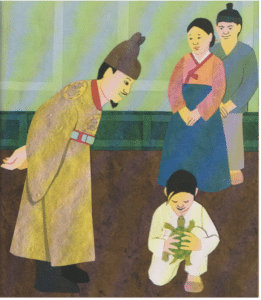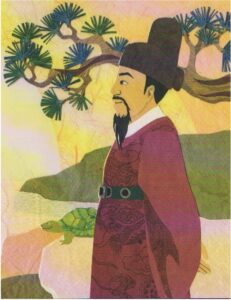
The Turtle Ship
- Fiction
- Set in Korea
Keywords: war, boats, animals, persistence
Loosely based on the true story of Admiral Yi Sun-sin and his Turtle Ship, this delightful tale introduces young readers to a fascinating episode in Korean history and naval engineering.
Long ago in Korea, a young boy named Sun-sin spent his days playing with his pet turtle Gobugi and dreaming of sailing around the world. As a poor villager, though, his dream to travel seemed impossible. Then one day, the king’s court announced a contest to find the best design for a new battleship to defend the land from invaders. The winner would sail the ocean with the royal navy.
Determined to win, Sun-sin attempts to build an indestructible battleship with a few found items. Each attempt fails miserably against the powerful sea, and with it Sun-sin’s dream also sinks to the bottom. Turning to Gobugi for comfort, Sun-sin notices how his pet turtle is small but mighty, slow but steady, and impossible to sink. Suddenly, Sun-sin has a great idea.
Genre: Historical Fiction
The Turtle Ship is a creative interpretation of historical events and figures. The historical figure Admiral Yi Sun-sin (1545–1598) (pronounced: ee SOON-shin) is credited with inventing and designing the first “turtle ships” (Gobukson or Geobukseon; pronounced: kaw-BOOK-suhn). In the 1590s, they proved instrumental in defending the country against invasions from Japan.
At that time, the Korean nobility (yangban; pronounced: yahng-bahn) was in turmoil due to rivalries and political intrigue. The family of Admiral Yi Sun-sin was also yangban, but Admiral Yi’s father and grandfather tended to avoid politics. Yi Sun-sin was known as a dedicated soldier who worked tirelessly to turn his great ideas into successful defense strategies to protect the Korean kingdom from invasion.
In contrast, the book’s protagonist, also named Sun-sin, lives by the sea in a fishing village (eochon; pronounced: AW-chohn). The villagers are humble folk whose social reality is far removed from the aristocracy.
Illustrations
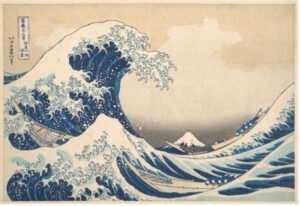
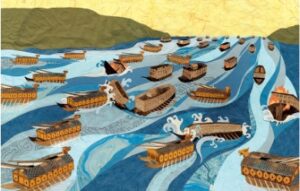
The Turtle Ship tells an original story inspired by historical figures from the 1500s. The illustrations for The Turtle Ship are similarly inspired by history. For example, the shape of the waves in the illustrations resemble the famous woodblock print The Great Wave off Kanagawa (c. 1830–1831) by the Japanese print designer Katsushika Hokusai (1760–1849). This work is also known as The Great Wave or simply The Wave.
History of Korean Shipbuilding
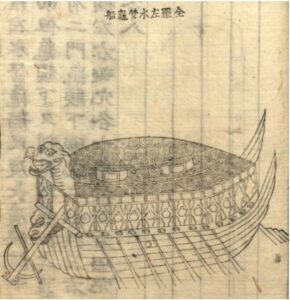
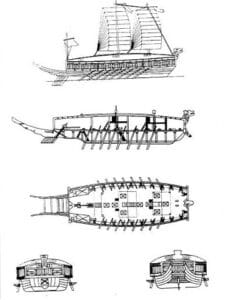
Korean seafaring and navigation date back thousands of years. The Geobukseon or turtle ship was successfully used to defend Korea in naval battles with Japan in the sixteenth century. The turtle ship was a great new idea in shipbuilding and a major accomplishment in both Korean maritime and world naval history. The ship itself was ironclad to repel attacks from above. Spikes lined the hull, and the bow of the vessel was carved to resemble the head of a dragon. The dragon could be used to fire canon or “spew flames and smoke to confound enemy ships.”
Turtles as Symbols
In Korean culture, turtles are symbols of longevity and loyalty. Turtles, along with dragons, have a special status in Korean mythology, and both have inspired works of art and design.
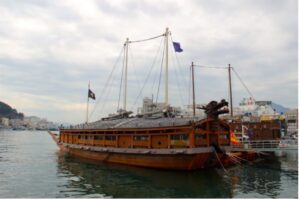
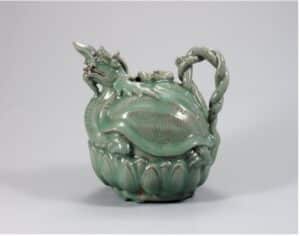
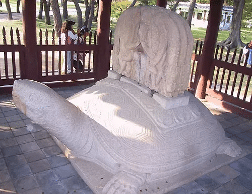
Admiral Yi Sun-sin
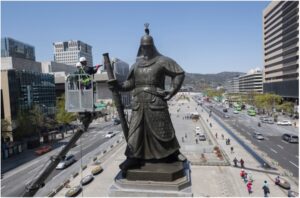
As mentioned, the family of the real Admiral Yi Sun-sin was yangban. Yi Sun-sin was known as a dedicated soldier who worked tirelessly to turn his great ideas into successful defense strategies to protect the Korean kingdom from invasion.
Korean Clothing: Hanbok
Hanbok (pronounced: HAHN-bohg) is a general term for Korean clothing. Hanbok come in many varieties, and as in all fashion, hanbok styles change over time and vary by region. While hanbok are featured in museum exhibits, folk villages, and historical dramas, people continue to wear hanbok for ceremonies and in everyday life.
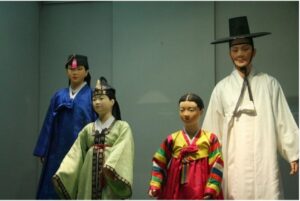
A woman’s hanbok consists of a short jacket (jeogori; pronounced: CHAW-GOH-lee) worn over a long, flowing skirt (chima; pronounced: CHEE-mah); this outfit has many variations and accessories. Men’s hanbok styles consist of a long jacket worn over pants (baji; pronounced: PAH-chee). Hats worn by men show their age and social status. More elaborate hats are worn by people with greater status or age. Hanbok are still worn in everyday life today.
In The Turtle Ship, Sun-sin and his family live in a fishing village. They dress in plain hanbok, with plain white for Sun-sin, and white or drab colors for Sun-sin’s father and the other men in the village. Sun-sin’s mother, in contrast to the royal women and the ladies of the court, wears no adornments with her hanbok.
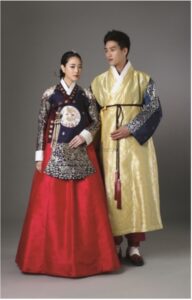
The clothing of the poor fishing villagers and of the common folk at court is contrasted with the ceremonial dress of court officers, nobles, and the king.
Korea long history includes many cultural variations over time, across regions, and throughout world politics. In the era depicted in The Turtle Ship, the Joseon Dynasty (1392–1897) (pronounced: choh-SUHN), various hairstyles were popular.
Both boys and girls would wear their hair long and in braids. Girls would tie the ends of their braids with a sash.
When they married, women would tie their hair into a single centered knot near the nape of the neck. This knot could be adorned with an ornament such as a hairpin called a binyeo (pronounced: PEE-nyaw). A binyeo could be made of various materials (for example, wood, metal, or jade) and carved into different shapes (for example, a dragon or phoenix) or with text. Men would wear their hair in a single knot on top of the head. Gentlemen would wear a hat, called a gat(pronounced: kaht), covering the topknot. Hats were elaborate and were used to signal rank, class, and occupation.
Social Class and Inequality
The court nobles in The Turtle Ship don’t listen to Sun-sin because he comes from a family of commoners. But the wise king understands the merit in Sun-sin’s idea.
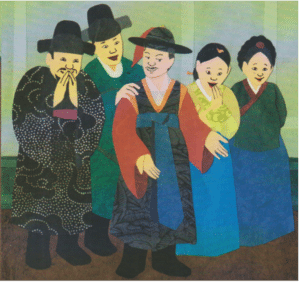
In pre-modern Korea, there were four social classes: royals and nobles, townspeople and merchants, commoners, and slaves or indentured servants. Strictly determined relationships dictated the interactions among royalty, aristocracy, townsfolk, villagers, and peasants. Thus, clothing, gestures, and even speech were used to mark social class so that people could know how to interact.
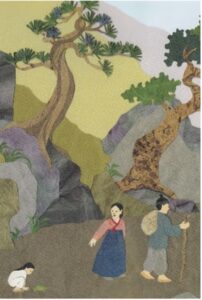
The character Sun-sin is the son of commoners from a poor fishing village, but he had a wonderful idea that he turned into an extraordinary invention. Many cultures have stories about people who rise above societal expectations through hard work and ability. Do you have an idea for something to improve society? Could you work hard to turn your idea into a reality?
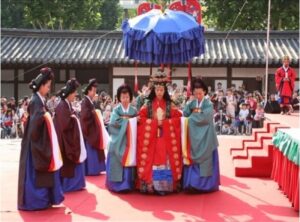
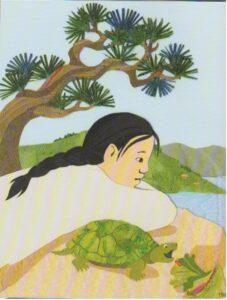
Authors:
Hye-Seung (Theresa) Kang, Ph.D., Director, Indiana University NCTA National Coordinating Site; Associate Director, East Asian Studies Center
Perry Miller, Ph.D., EdD Student in Literacy, Culture, and Language Education, Department of Curriculum and Instruction, Indiana University; Senior Lecturer, Department of East Asian Languages and Literatures, Ohio State University
2021
Overview
Yi Sun-sin is inspired by his pet turtle to create an ironclad battleship that is difficult to sink. Because Sun-sin is so young, no one believes in his ideas until a cat attacks his turtle and the turtle is unharmed. The King is impressed and orders Yi Sun-sin’s ships to be built. These new ships help Korea defeat an invading enemy force.
Reading Levels
Independent Read: Ages 5–8
Read-aloud: Grades K–12
Length: 32 pages
Concepts
Characters
Admiral Yi Sun-sin (pronounced: ee SOON-shin): By most accounts, Sun-sin created the first armored ship, the Gobukson (pronounced: kaw-BOOK-suhn), and developed a new approach to naval warfare that helped defeat the invading Japanese in the 1592 Imjin War. For this, he was promoted to Supreme Admiral Commander. Although he didn’t survive the war, his Gobukson was a great success.
Gobugi (pronounced: goh-BOO-gee): Yi Sun-sin’s pet and inspiration. Turtles are an auspicious symbol in Korea and represent long life. In mythology, the turtle is a bearer of good news in water.
King: Though the King is never named in this book, King Seonjo reigned during the Imjin War and promoted Yi Sun-sin to Supreme Admiral Commander. He made the decision not to allow Japanese troops access to Korea on their way to invade China, which started the Imjin War (1592–1598).
Vocabulary
Gobukson: These “turtle boats” of Korea are recognized as the first ironclad boats in history. Their exact schematics are not known.
Joseon dynasty (pronounced: choh-SUHN): This dynasty was the longest in Korean history. It began in 1392 and ended when Japan annexed Korea in 1910. Although not specifically named in the book, this dynasty was the unifying factor on the peninsula during this time.
Possible Curricular Unit Themes
- Perseverance (English)
- Animal Adaptations (Science)
- Animal Adaptations as Answers for Human Problems (Science)
- Physical Geography of Korean Peninsula (Social Studies)
- Collage (art)
- Location of Capitals (Social Studies)
- Interaction of Political Worlds (Social Studies)
Essential Questions
- What is resilience?
- What is strength?
- How does failure lead to success?
- What does it mean to follow your dreams?
Close Reading Questions
- Where is Yi Sun-sin from?
- Where does Yi Sun-sin get his inspiration from?
- What does Yi Sun-sin try before his final idea?
- Why does Yi Sun-sin’s last idea work?
- Why does Yi Sun-sin go to the capital?
- Why does the king not take Yi Sun-sin seriously?
- What does the king see that makes him change his mind?
- How do Yi Sun-sin’s dreams come true?
Discussion Prompts
- Talk about a time you failed and what made you persevere.
- Discuss what strength is. Compare it to either Yi Sun-sin or Gobugi.
- Discuss what resilience is. Compare it to Yi Sun-sin.
- Write a story based on a personal experience when you failed yet tried again.
- When were you inspired by something?
- How do your dreams motivate you?
- How does it feel to not be listened to?
Suggested Activities
Lower Grade Level:
Animal Adaptations. Before reading the book, have students choose an animal and identify the parts that help it to survive. You might also ask students to create an animal that has different characteristics such as “tough” or “sneaky.” After reading the book, ask students to analyze what parts of the turtle help it to survive and how Yi Sun-Sin adapted these characteristics to solve a human problem. Then students can select another animal or plant, identify the parts that help it, and use these characteristics to design a solution to a human problem.
Inference: Before they read the book, ask students to draw and label what they think a “Turtle Ship” would look like. After they read the book, ask them to look at their drawings again, comparing their ships to the way historians think they may have looked and discussing how their ideas have changed after reading.
Analysis of Physical Features Maps: To understand Yi Sun-sin’s journey and the location of the capital, students could use a physical features map of the Korean Peninsula to try to figure out the route he might have taken to visit the king. Or ask students to create their own maps of Sun-sin’s journey to the capital. Students could then compare his journey with one they might take to their own capital or to school.
Analysis of Political Maps: To learn about East Asia, students could use a political map and physical features map to determine which modern-day countries he could have easily traveled to during his days with the Royal Navy.
Collage: This book is full of beautiful collages created by Colleen Kong-Savage. Students could “jigsaw” a two-page spread to identify what different materials and paper they see on the pages. This could lead to the creation of a picture using many different materials, unified to convey an idea.
Storybook: Using the book as a model, students can write, edit, and illustrate their own personal stories about a time that they overcame an obstacle.
Secondary Grade Level:
The detail in this book is not suitable for teaching content to students at the secondary level. But it can be used as inspiration for other activities and learning.
Geopolitical Connections: This book can serve as a springboard into conversations about geopolitical relations in East Asia, in particular, the location of Korea between Japan and China. Some extra context will be needed for students to fully understand the complexities of this area (see suggested readings).
Storybook Creation: This book can be a model for students to create their own storybook about a historical event, person, or invention. After reading this book, students could research about the Imjin War and Yi Sun-Sin to identify differences between history and the story in the book. Then they could select a different event, person, or invention and create a storybook around that.
Suggested Readings/Bibliography
Seoul Museum of History. “The Joseon Capital 1392–1863,” n.d.
Author: Rachel Knowles, 9–12 history and film teacher, Southwick Regional School, Southwick, MA
2025
Publisher’s Teacher’s Guide

